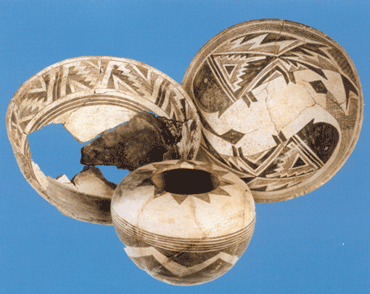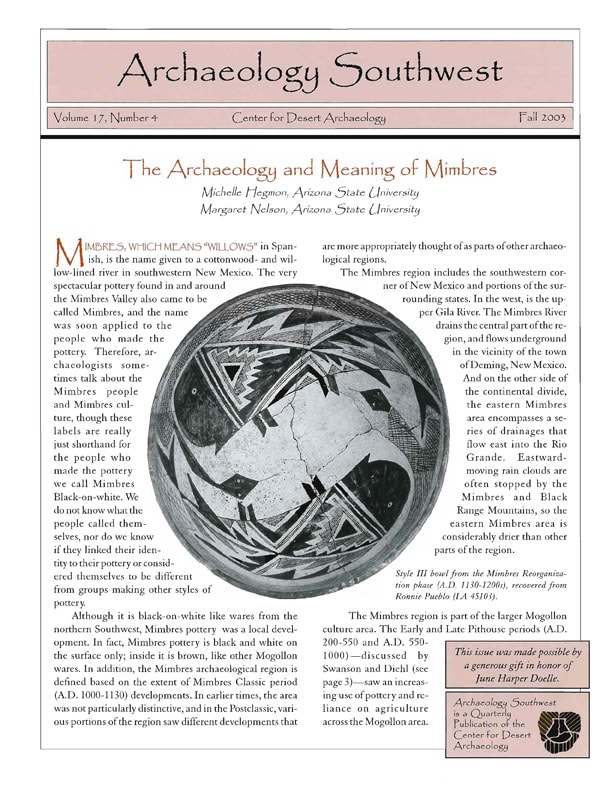The Archaeology and Meaning of Mimbres

Two Classic Mimbres Black-on-white bowls and a Chupadero Black-on-white seed jar. All three were recovered from Ronnie Pueblo, a Reorganization phase hamlet.
Archaeology Southwest Magazine Vol. 17, No. 4
FREE PDF DOWNLOAD
Michelle Hegmon and Margaret Nelson
Arizona State University
Mimbres, which means “willows” in Spanish, is the name given to a cottonwood- and willow-lined river in southwestern New Mexico. The very spectacular pottery found in and around the Mimbres Valley also came to be called Mimbres, and the name was soon applied to the people who made the pottery. Therefore, archaeologists sometimes talk about the Mimbres people and Mimbres culture, though these labels are really just shorthand for the people who made the pottery we call Mimbres Black-on-white. We do not know what the people called themselves, nor do we know if they linked their identity to their pottery or considered themselves to be different from groups making other styles of pottery.
Although it is black-on-white like wares from the northern Southwest, Mimbres pottery was a local development. In fact, Mimbres pottery is black and white on the surface only; inside it is brown, like other Mogollon wares. In addition, the Mimbres archaeological region is defined based on the extent of Mimbres Classic period (A.D. 1000-1130) developments. In earlier times, the area was not particularly distinctive, and in the Postclassic, various portions of the region saw different developments that are more appropriately thought of as parts of other archaeological regions.
The Mimbres region includes the southwestern corner of New Mexico and portions of the surrounding states. In the west, is the upper Gila River. The Mimbres River drains the central part of the region, and flows underground in the vicinity of the town of Deming, New Mexico. And on the other side of the continental divide, the eastern Mimbres area encompasses a series of drainages that flow east into the Rio Grande. Eastward-moving rain clouds are often stopped by the Mimbres and Black Range Mountains, so the eastern Mimbres area is considerably drier than other parts of the region.
The Mimbres region is part of the larger Mogollon culture area. The Early and Late Pithouse periods (A.D. 200-550 and A.D. 550-1000)-discussed by Swanson and Diehl-saw an increasing use of pottery and reliance on agriculture across the Mogollon area. However, by the latter part of the Late Pithouse period, the Mimbres tradition-including early types of Mimbres Black-on-white pottery-became more distinctive and elaborate. Villages grew, large kivas were constructed, and around 900, these community ritual structures were ceremonially destroyed in spectacular conflagrations, a major social and ritual transition recently recognized and here described by Creel and Anyon.
The Mimbres Classic period is characterized by pueblos; densely packed villages along the Mimbres River valley; fairly heavy reliance on agriculture watered by small irrigation systems; and elaborate, sometimes naturalistic, pottery designs. Gilman and Shafer discuss Classic village formation and growth, while Brody and Hegmon consider aspects of Classic pottery design.
Previous researchers saw the Late Pithouse and Classic periods as times of rapid growth, environmental degradation, and the eventual collapse and abandonment associated with a climatic downturn in the early twelfth century. We review less dramatic-but probably more accurate-interpretations in this issue of Archaeology Southwest. Most importantly, although many large villages were depopulated around A.D. 1130, settlement continued in other villages, and people remained in the region in new kinds of smaller, hamlet-style settlements. Consequently, the change is better characterized as a regional reorganization rather than as an abandonment.
Different developments in different parts of the region illustrate the changing nature of archaeological traditions. The western Mimbres area, around the Upper Gila, was depopulated fairly early (probably before A.D. 1100), and was not permanently settled again until around 1300 (the Saladoan Cliff phase). The northern Mimbres Valley was mostly depopulated after 1130. However, the central and especially southern parts of the valley saw very late transitional developments known as the Terminal Classic (A.D. 1130-1200).
At the same time, in the eastern Mimbres area, there is strong evidence of continuity from Classic villages to slightly later occupation of dispersed residential hamlets, known as the Reorganization phase, because their occupation represents a reorganization of land use that probably enabled people to remain in the region. By the later A.D. 1200s, the entire southern portion of what had been the Mimbres region is better understood as part of what is currently known as the Southern Desert phenomenon, associated with the eventual rise of Casas Grandes (also known as Paquimé). Concurrently, the northern portion of the region became incorporated into the Tularosa tradition.
Much of what we know and continue to study in the Mimbres region has been possible because of the preservation efforts of local land owners, agencies, and archaeologists. LeBlanc describes the history of preservation developments in the Mimbres region and elsewhere. In our own experience, directing the Eastern Mimbres Archaeological Project, property owners-such as Ted Turner and the Ladder Ranch, and the owners of the A-Spear Ranch/Las Palomas Land and Cattle Company-have worked diligently to protect archaeological sites and they have generously supported our research.
This issue was made possible by a generous gift in honor of June Harper Doelle.
Issue Editors: Michelle Hegmon and Margaret Nelson, Arizona State University
Articles Include:
- Mimbres Pithouse Dwellers – Steve Swanson, Arizona State University, and Michael W. Diehl, Desert Archaeology, Inc.
- Ritual and Societal Transformation at the End of the Late Pithouse Period – Darrell Creel, University of Texas, Austin, and Roger Anyon, Pima County Cultural Resources Office
- Mimbres Families and Households – Patricia A. Gilman, University of Oklahoma, and Harry J. Shafer, Texas A&M University
- Mimbres Painted Pottery in the Modern World – J. J. Brody, University of New Mexico
- Mimbres Pottery: Meaning and Content – Michelle Hegmon, Arizona State University
- The End of the Mimbres Classic Period – Michelle Hegmon, Arizona State University
- Abandonment Is Not As It Seems – Margaret Nelson, Arizona State University
- Mimbres Archaeology and Site Preservation – Steven A. LeBlanc, Peabody Museum of Archaeology and Ethnology
- Styles Change, People Continue – Michelle Hegmon, Arizona State University
Subscribe

